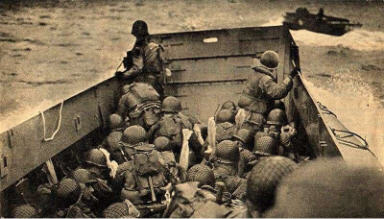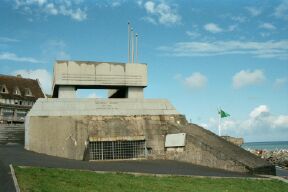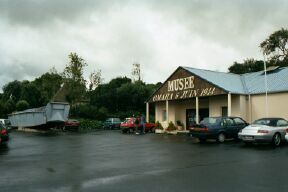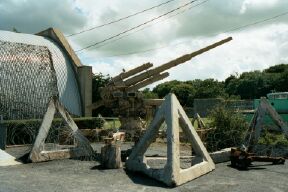![]() OMAHA
BEACH
OMAHA
BEACH ![]()

"As the first men jumped, they crumpled and flopped into the water. Then order was lost. It seemed to the men that the only way to get ashore was to dive head first in and swim clear of the fire that was striking the boats. But, as they hit the water, their heavy equipment dragged them down and soon they were struggling to keep afloat. Some were hit in the water and wounded. Some drowned then and there... But some moved safely through the bullet fire to the sand and the, finding they could not hold there, went back in to the water and used it as cover, only their heads sticking out. Those who survived kept moving with the tide, sheltering at times behind underwater obstacles and in this way they finally made their landings.
Within ten minutes of the ramps being lowered, Company A had become inert, leaderless and almost incapable of action. Every officer and Sergeant had been killed or wounded... It had become a struggle for survival and rescue. The men in the water pushed wounded men ashore, and those who had reached the sands crawled back into the water pulling others to land to save them from drowning, in many cases only to see the rescued men wounded again or to be hit themselves. Within twenty minutes of striking the beach Company A had ceased to be an assault company and had become a forlorn little rescue party bent upon survival and the saving of lives."
Official Unit Report, Company A, 116th Infantry, 29th Division.
What happened at Omaha Beach on 6th June 1944 has been immortalised in recent films and books, most notably the epic opening sequence of Saving Private Ryan. That Omaha was a bloodbath is certain; that it could have been avoided is a matter of debate, and one that we shall not enter into here.
Unlike most of the Allied landing beaches on D Day, Omaha differed in that it was dominated by a series of high bluffs that looked down onto the beach. This gave the defenders high ground to dominate the battlefield, and the Germans placed a large number of concrete bunkers on these bluffs, containing machine guns and artillery pieces. Again unlike some of the other D Day beaches, this sector was defended by an experienced, albeit under strength, division, the 352nd. This had been formed from a cadre of Russian front veterans, some of whom had years of combat experience. They had begun anti-invasion maneuvers on the eve of D Day, and so were in a state of high alert when the invasion started.
The two American assault units selected to land here on D Day were the 1st Division ('Big Red One') and 29th Division. The former was a veteran formation, that had been in action since 1943. The latter was a National Guard unit, with little or no combat experience. In addition there would be support from the 2nd Ranger Battalion, as well as tank units utilising the special Duplex Drive Shermans capable of wading ashore. However, other specialist armour developed by the British (the so-called 'Funnies') had been shunned by the Americans and were not available for this beach.
The main beach was subdivided into sections, with the 1st Division landing in the east, and 29th in the west. The American forces lacked landing craft for D Day, and much of the transport was supplied by the Royal Navy. AB John Marketis, serving on one of them, later recalled,
" As we went in the Yanks said to me, 'Don't worry Limey, the war's over now - we're here.' But as we got nearer shells were exploding in the water, and as the ramp came down just short of the shoreline, machine gun fire cut them to pieces. Most never got more than a few yards from the ramp. Our landing craft was hit, and I was thrown into the water."
Meanwhile, the DD tanks had been launched two to three miles out from the shore. Poor weather in the channel accounted for most of them, and of the thirty-two attached to 1st Division, twenty-seven were sunk. This meant that few reached the beach, and as a consequence there was little fire support available to the infantry.

National Guard Memorial, Omaha Beach
As the survivors dragged themselves up the beach, along the entire Omaha front most units were pinned down with heavy losses. Objectives had been forgotten, and it became a matter for simple survival among the shell fire and continuous machine gun fire. As the second wave approached at 07.00, they feared little better than the first. Heavy fire from both British and American naval vessels off-shore at last began to rake the German defences, and aboard USS Augusta, General Omar Bradley, commanding the assault, looked at the reports and feared the worst. However, spurred on by the surviving officers, the men on Omaha beach gradually fought their way onto the bluffs and began to silence the defenders. By the close of the day, the village of Vierville was in American hands, as were all five of the access roads ('draws') from the main beach.
But the cost had been considerable; 3,000 American personnel killed, wounded and missing. The landings here were soon dubbed, 'Bloody Omaha'.
OMAHA BEACH TODAY
This is one of the most visited of all the D Day beaches, and little has changed in terms of the geography of the battlefield. The bluffs still dominate, and all the German defences can be seen, including signs of trenches here and there. The huge American Cemetery at St Laurant overlooks the 1st Division sector, and you can actually walk along the entire beach from here to the 29th Division sector, and indeed beyond to Pointe du Hoc.

Musée Omaha 6 Juin 1944
Close by is the Musee Omaha 6 Juin 1944. This excellent war museum tells the story of the landings on Omaha Beach with a vast amount of original uniforms, equipment, weapons and vehicles. It is open from February to November every year, and during July and August remains open all day from 09.30-19.00. For further details contact:
Musée Omaha 6 Juin 1944
"Les Moulins"
Rue de la Mer
14710 Saint Laurent sur Mer
Tel: 02.31.21.97.44. Fax: 02.31.92.72.80.
http://www.musee-memorial-omaha.com/
email : [email protected]
[email protected]
Not far away in Vierville is the Musée D Day Omaha. Although much smaller, it has some superb exhibits including original concrete 'dragons teeth', landing craft and a huge steel observation cupola from a bunker at Cherbourg. Open from April to November, between June and September it is open from 09.30-19.30 every day.

Musée D Day Omaha
For further details contact:
Musée D Day Omaha
Route de Grandcamp
14710 Vierville-sur-Mer
Tel/Fax: 02.31.21.71.80.
http://www.vierville-sur-mer.com/
©PAUL REED 2002-2006
![]()